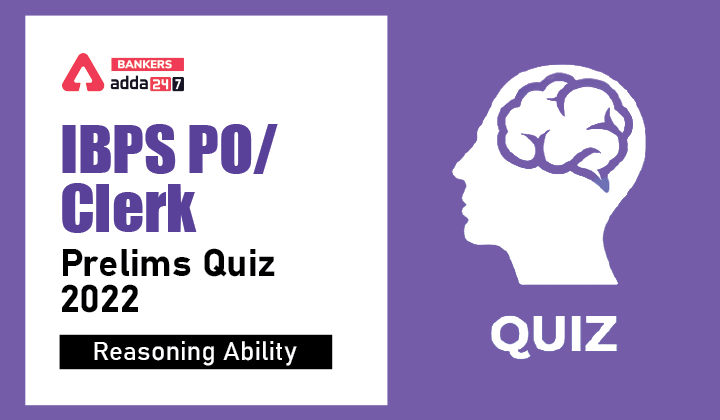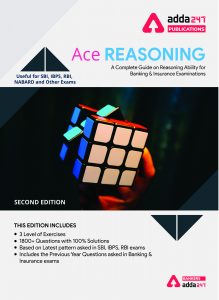Directions (1-5): Study the following information carefully and answer the questions given below:
Eight persons P, Q, R, S, T, U, V and W are sitting around a circular table in such a way that all of them are facing outside, but not necessarily in the same order. All of them are going to visit different places i.e., Delhi, Kolkata, Mumbai, Ahmedabad, Goa, Patna, Lucknow and Uttarakhand, but not necessarily in the same order.
Two persons sit between R and S, who sits opposite to the one who visit Delhi. T is neither immediate neighbor of W, nor R. R sits second to left of W, who visits Mumbai. P sits opposite to U, who is immediate neighbor of W. The one who visit to Uttarakhand is not an immediate neighbor of U and P. T and R do not visit Goa. The one who visit to Ahmedabad sits immediate to the right of the one who visit Mumbai. S does not visit Ahmedabad and Patna. T is an immediate neighbor of the one who visit Patna. Q does not visit Delhi. The one who visit Lucknow does not sit opposite to the one, who visit Goa. S does not visit Lucknow and Goa.
Q1. Who sits second to the left of the person who visit Kolkata?
(a) T
(b) P
(c) V
(d) Q
(e) None of these
Q2. What is the position of S with respect to the person who visit Ahmedabad?
(a) Third to the right
(b) Fourth to the right
(c) Second to the right
(d) Third to the left
(e) None of these
Q3. Who among the following visit Goa?
(a) W
(b) Q
(c) P
(d) T
(e) None of these
Q4. Four of the following five are alike in a certain way and so form a group. Which is the one that does not belong to the group?
(a) S-V
(b) T-W
(c) P-U
(d) Q-R
(e) T-S
Q5. Which of the following is true regarding U?
(a) U is an immediate neighbor of T
(b) U faces the one who visit Patna
(c) U sits immediate left of W
(d) U sits third to the left of T
(e) None of these
Q6. Which of the following elements should come in a place ‘?’ ?
LO9 JQ49 GT144 ?
(a) BY196
(b) DW126
(c) DW324
(d) CX324
(e) None of these
Q7. How many meaningful words can be formed from the 3rd, 5th and 6th letter of a word ‘DIGITAL’ and 1st, 5th, and 7th letter of a word ‘Respect’ by using these six letters in the word?
(a) two
(b) one
(c) none
(d) three
(e) more than three
Q8. Which of the following word is third to the right if, all vowels are replaced by the preceding letter and all consonant replaced with next letter in the word ‘INTERVIEW’, and then all vowel are eliminated, after that all words are arranged in alphabetical order from left to right?
(a) S
(b) H
(c) D
(d) V
(e) None of these
Q9. How many pairs of letters are there in the word ‘PARLIAMENT’, each of which have as many letters between then in the word as they have between then in the English alphabet?
(a) Three
(b) One
(c) Two
(d) Four
(e) None
Q10. If in the number 635729481, 1 is added to first four digit of the number and 1 is subtracted from last five digits of the number and then arranged in descending order from left to right, then which of the following if fourth from the left end?
(a) 7
(b) 6
(c) 4
(d) 3
(e) 1
Direction (11-15): In each of the questions below some statements are given followed by some conclusions. You have to take the given statements to be true even if they seem to be at variance with commonly known facts. Read all the conclusions and then decide which of the given conclusions logically follows from the given statements disregarding commonly known facts.
(a) If only conclusion I follows.
(b) If only conclusion II follows.
(c) If either conclusion I or II follows.
(d) If neither conclusion I nor II follows.
(e) If both conclusions I and II follow.
Q11. Statements: P ≥H >T= Y >Q ≤N >E <F
Conclusions: I. P > N II. F< H
Q12. Statements: Z ≥S >N = C ≥ V; V>J >L ≥ H
Conclusions: I. L< N II. H ≤ V
Q13. Statements: F > S > T ≥ H > D; F ≤ L = J < G
Conclusions: I. J > H II. S < G
Q14. Statements: M > N ≥ R = T > L; M ≤ E < B; L < W > A
Conclusions: I. E > T II. A ≤ M
Q15. Statements: M > K = L> N ≥ A; M ≤ L = O ≤ P < V
Conclusions: I. N < P II. M ≤P
Solutions
Solutions (1-5):
Sol.

S1. Ans. (a)
S2. Ans. (c)
S3. Ans. (b)
S4. Ans. (e)
S5. Ans. (d)
S6. Ans. (d)
S7. Ans. (b)
Sol. Target
S8. Ans. (a)
Sol. Original word- INTERVIEW
After Replacement- HOUDSWHDX
After eliminating Vowels- HDSWHDX
Arrange Alphabetically- DDHHSWX
S9. Ans. (b)
S10. Ans. (a)
Sol. Original Number- 635729481
After applied condition- 746818370
Obtained number- 887764310
S11. Ans. (d)
Sol. I. P >N(False) II. F <H(False)
S12. Ans. (a)
Sol. I. L <N(True) II. H ≤ V(False)
S13. Ans. (e)
Sol. I. J >H(True) II. S <G(True)
S14. Ans. (a)
Sol. I. E >T(True) II. A ≤ M(False)
S15. Ans. (e)
Sol. I. N <P(True) II. M ≤ P(True)





 GA Capsule for SBI Clerk Mains 2025, Dow...
GA Capsule for SBI Clerk Mains 2025, Dow...
 The Hindu Review October 2022: Download ...
The Hindu Review October 2022: Download ...
 SBI PO Syllabus 2025, Check Subject Wise...
SBI PO Syllabus 2025, Check Subject Wise...


